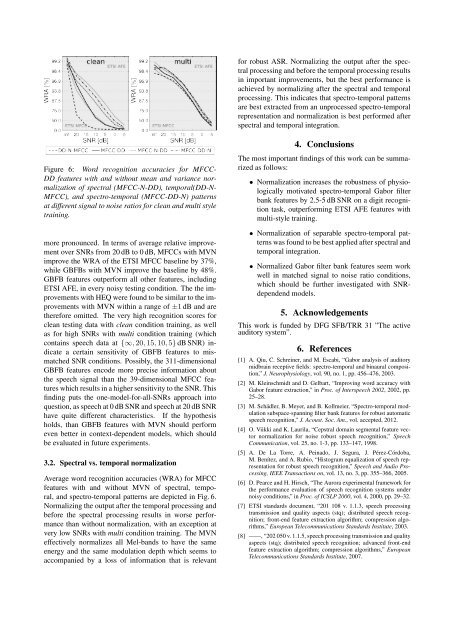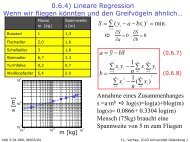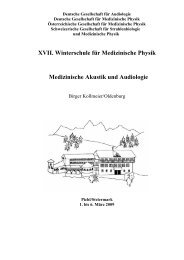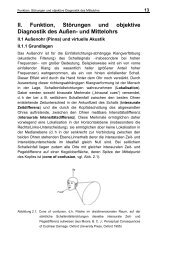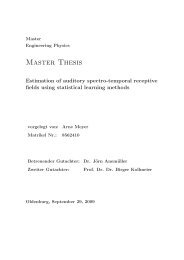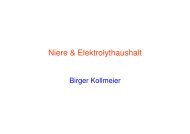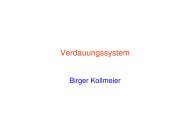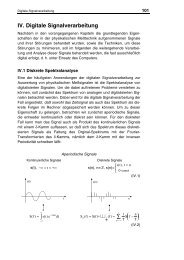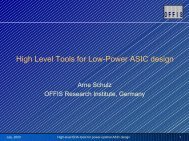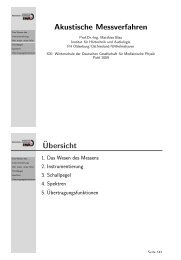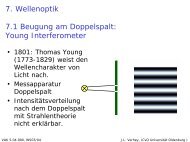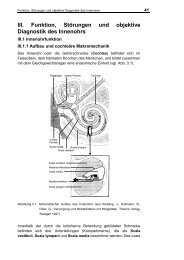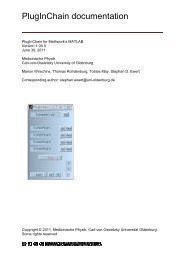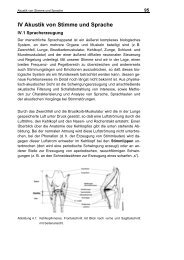Wed.P7c.05 Normalization of Spectro-Temporal Gabor Filter Bank ...
Wed.P7c.05 Normalization of Spectro-Temporal Gabor Filter Bank ...
Wed.P7c.05 Normalization of Spectro-Temporal Gabor Filter Bank ...
Create successful ePaper yourself
Turn your PDF publications into a flip-book with our unique Google optimized e-Paper software.
Figure 6: Word recognition accuracies for MFCC-<br />
DD features with and without mean and variance normalization<br />
<strong>of</strong> spectral (MFCC-N-DD), temporal(DD-N-<br />
MFCC), and spectro-temporal (MFCC-DD-N) patterns<br />
at different signal to noise ratios for clean and multi style<br />
training.<br />
more pronounced. In terms <strong>of</strong> average relative improvement<br />
over SNRs from 20 dB to 0 dB, MFCCs with MVN<br />
improve the WRA <strong>of</strong> the ETSI MFCC baseline by 37%,<br />
while GBFBs with MVN improve the baseline by 48%.<br />
GBFB features outperform all other features, including<br />
ETSI AFE, in every noisy testing condition. The the improvements<br />
with HEQ were found to be similar to the improvements<br />
with MVN within a range <strong>of</strong> ±1 dB and are<br />
therefore omitted. The very high recognition scores for<br />
clean testing data with clean condition training, as well<br />
as for high SNRs with multi condition training (which<br />
contains speech data at {∞, 20, 15, 10, 5} dB SNR) indicate<br />
a certain sensitivity <strong>of</strong> GBFB features to mismatched<br />
SNR conditions. Possibly, the 311-dimensional<br />
GBFB features encode more precise information about<br />
the speech signal than the 39-dimensional MFCC features<br />
which results in a higher sensitivity to the SNR. This<br />
finding puts the one-model-for-all-SNRs approach into<br />
question, as speech at 0 dB SNR and speech at 20 dB SNR<br />
have quite different characteristics. If the hypothesis<br />
holds, than GBFB features with MVN should perform<br />
even better in context-dependent models, which should<br />
be evaluated in future experiments.<br />
3.2. Spectral vs. temporal normalization<br />
Average word recognition accuracies (WRA) for MFCC<br />
features with and without MVN <strong>of</strong> spectral, temporal,<br />
and spectro-temporal patterns are depicted in Fig. 6.<br />
Normalizing the output after the temporal processing and<br />
before the spectral processing results in worse performance<br />
than without normalization, with an exception at<br />
very low SNRs with multi condition training. The MVN<br />
effectively normalizes all Mel-bands to have the same<br />
energy and the same modulation depth which seems to<br />
accompanied by a loss <strong>of</strong> information that is relevant<br />
for robust ASR. Normalizing the output after the spectral<br />
processing and before the temporal processing results<br />
in important improvements, but the best performance is<br />
achieved by normalizing after the spectral and temporal<br />
processing. This indicates that spectro-temporal patterns<br />
are best extracted from an unprocessed spectro-temporal<br />
representation and normalization is best performed after<br />
spectral and temporal integration.<br />
4. Conclusions<br />
The most important findings <strong>of</strong> this work can be summarized<br />
as follows:<br />
• <strong>Normalization</strong> increases the robustness <strong>of</strong> physiologically<br />
motivated spectro-temporal <strong>Gabor</strong> filter<br />
bank features by 2.5-5 dB SNR on a digit recognition<br />
task, outperforming ETSI AFE features with<br />
multi-style training.<br />
• <strong>Normalization</strong> <strong>of</strong> separable spectro-temporal patterns<br />
was found to be best applied after spectral and<br />
temporal integration.<br />
• Normalized <strong>Gabor</strong> filter bank features seem work<br />
well in matched signal to noise ratio conditions,<br />
which should be further investigated with SNRdependend<br />
models.<br />
5. Acknowledgements<br />
This work is funded by DFG SFB/TRR 31 ”The active<br />
auditory system”.<br />
6. References<br />
[1] A. Qiu, C. Schreiner, and M. Escabi, “<strong>Gabor</strong> analysis <strong>of</strong> auditory<br />
midbrain receptive fields: spectro-temporal and binaural composition,”<br />
J. Neurophysiology, vol. 90, no. 1, pp. 456–476, 2003.<br />
[2] M. Kleinschmidt and D. Gelbart, “Improving word accuracy with<br />
<strong>Gabor</strong> feature extraction,” in Proc. <strong>of</strong> Interspeech 2002, 2002, pp.<br />
25–28.<br />
[3] M. Schädler, B. Meyer, and B. Kollmeier, “<strong>Spectro</strong>-temporal modulation<br />
subspace-spanning filter bank features for robust automatic<br />
speech recognition,” J. Acoust. Soc. Am., vol. accepted, 2012.<br />
[4] O. Viikki and K. Laurila, “Cepstral domain segmental feature vector<br />
normalization for noise robust speech recognition,” Speech<br />
Communication, vol. 25, no. 1-3, pp. 133–147, 1998.<br />
[5] A. De La Torre, A. Peinado, J. Segura, J. Pérez-Córdoba,<br />
M. Benítez, and A. Rubio, “Histogram equalization <strong>of</strong> speech representation<br />
for robust speech recognition,” Speech and Audio Processing,<br />
IEEE Transactions on, vol. 13, no. 3, pp. 355–366, 2005.<br />
[6] D. Pearce and H. Hirsch, “The Aurora experimental framework for<br />
the performance evaluation <strong>of</strong> speech recognition systems under<br />
noisy conditions,” in Proc. <strong>of</strong> ICSLP 2000, vol. 4, 2000, pp. 29–32.<br />
[7] ETSI standards document, “201 108 v. 1.1.3, speech processing<br />
transmission and quality aspects (stq); distributed speech recognition;<br />
front-end feature extraction algorithm; compression algorithms,”<br />
European Telecommunications Standards Institute, 2003.<br />
[8] ——, “202 050 v. 1.1.5, speech processing transmission and quality<br />
aspects (stq); distributed speech recognition; advanced front-end<br />
feature extraction algorithm; compression algorithms,” European<br />
Telecommunications Standards Institute, 2007.


